NRSG366: Case Study Analysis of Peter Mitchell's Health Complications
VerifiedAdded on 2023/01/19
|7
|2692
|37
Case Study
AI Summary
This case study analyzes the healthcare complications of Peter Mitchell, a 52-year-old patient suffering from type 2 diabetes, sleep apnoea, and weight gain. The analysis begins with an assessment of Peter's medical history, including his smoking habits, job history, and social situation, highlighting the interplay of factors contributing to his poor health. The study then identifies two primary healthcare priorities: managing his sleep apnoea and addressing his weight gain, both of which are linked to his diabetes. The paper proposes interventions such as patient education, breathing exercises, corticosteroid use, and weight management strategies. The case study emphasizes the importance of the clinical reasoning cycle in identifying and prioritizing interventions, setting SMART goals, and evaluating the effectiveness of the care plan. The interventions aim to improve Peter's overall health and quality of life by focusing on both physical and mental healthcare needs.
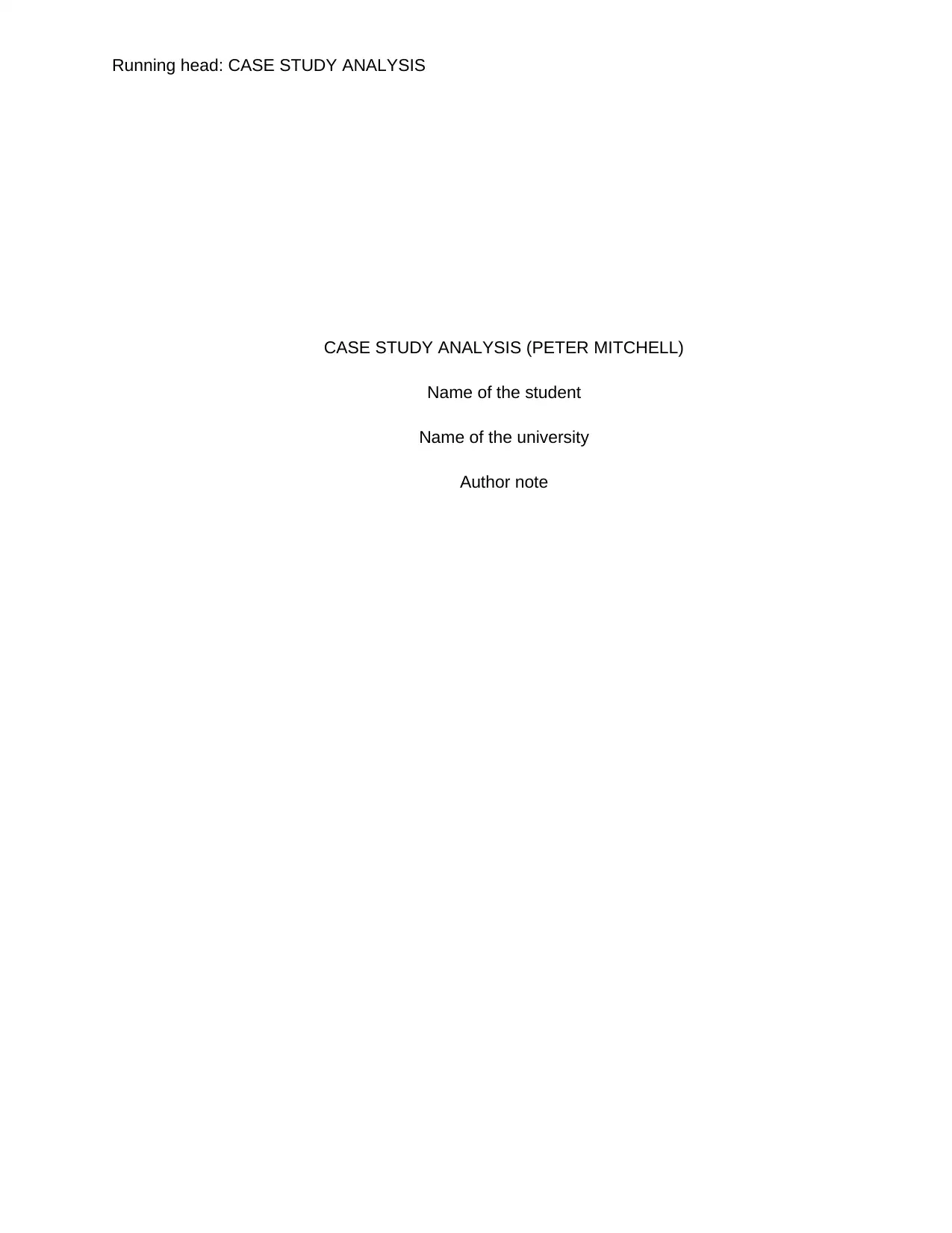
Running head: CASE STUDY ANALYSIS
CASE STUDY ANALYSIS (PETER MITCHELL)
Name of the student
Name of the university
Author note
CASE STUDY ANALYSIS (PETER MITCHELL)
Name of the student
Name of the university
Author note
Paraphrase This Document
Need a fresh take? Get an instant paraphrase of this document with our AI Paraphraser
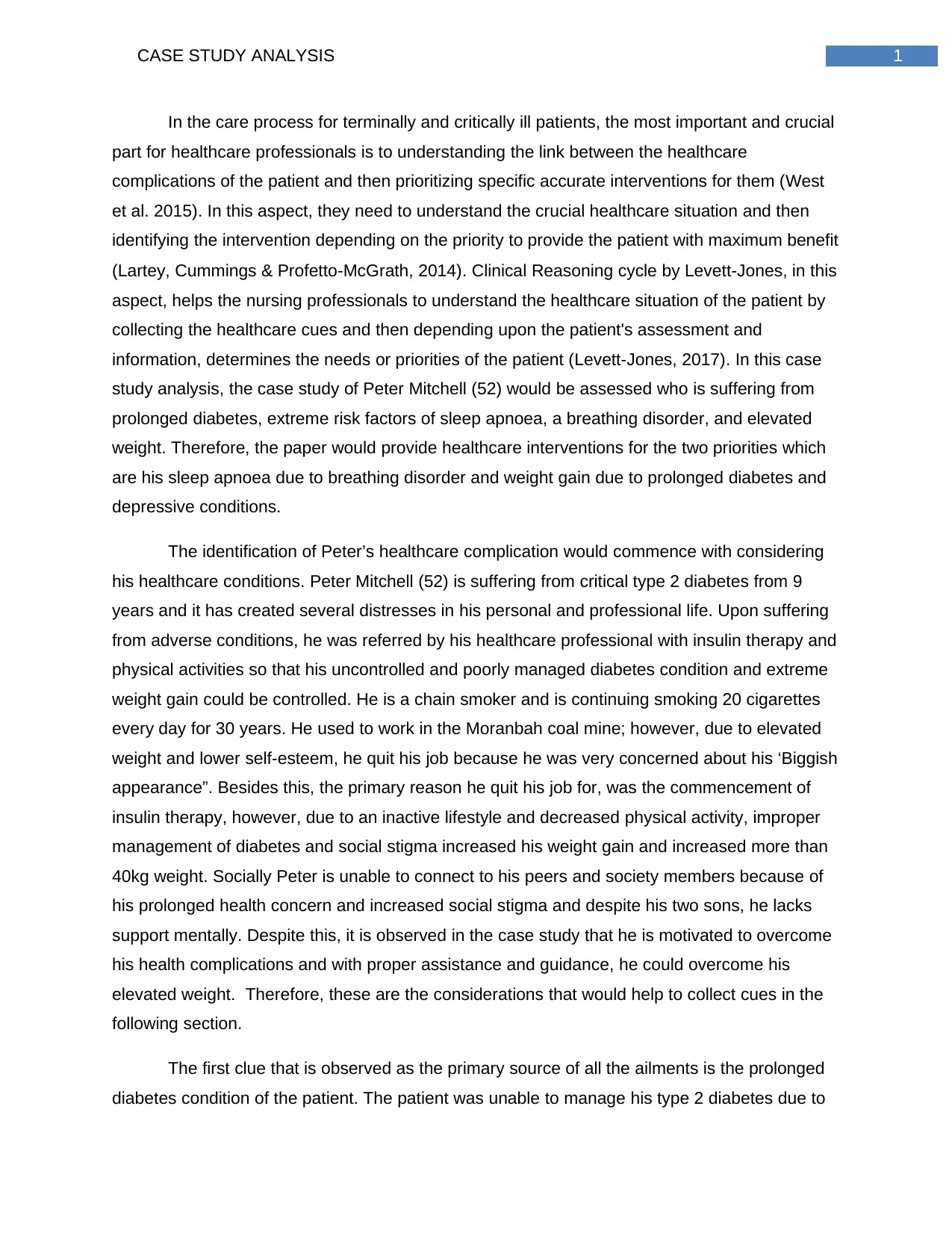
1CASE STUDY ANALYSIS
In the care process for terminally and critically ill patients, the most important and crucial
part for healthcare professionals is to understanding the link between the healthcare
complications of the patient and then prioritizing specific accurate interventions for them (West
et al. 2015). In this aspect, they need to understand the crucial healthcare situation and then
identifying the intervention depending on the priority to provide the patient with maximum benefit
(Lartey, Cummings & Profetto‐McGrath, 2014). Clinical Reasoning cycle by Levett-Jones, in this
aspect, helps the nursing professionals to understand the healthcare situation of the patient by
collecting the healthcare cues and then depending upon the patient's assessment and
information, determines the needs or priorities of the patient (Levett-Jones, 2017). In this case
study analysis, the case study of Peter Mitchell (52) would be assessed who is suffering from
prolonged diabetes, extreme risk factors of sleep apnoea, a breathing disorder, and elevated
weight. Therefore, the paper would provide healthcare interventions for the two priorities which
are his sleep apnoea due to breathing disorder and weight gain due to prolonged diabetes and
depressive conditions.
The identification of Peter’s healthcare complication would commence with considering
his healthcare conditions. Peter Mitchell (52) is suffering from critical type 2 diabetes from 9
years and it has created several distresses in his personal and professional life. Upon suffering
from adverse conditions, he was referred by his healthcare professional with insulin therapy and
physical activities so that his uncontrolled and poorly managed diabetes condition and extreme
weight gain could be controlled. He is a chain smoker and is continuing smoking 20 cigarettes
every day for 30 years. He used to work in the Moranbah coal mine; however, due to elevated
weight and lower self-esteem, he quit his job because he was very concerned about his ‘Biggish
appearance”. Besides this, the primary reason he quit his job for, was the commencement of
insulin therapy, however, due to an inactive lifestyle and decreased physical activity, improper
management of diabetes and social stigma increased his weight gain and increased more than
40kg weight. Socially Peter is unable to connect to his peers and society members because of
his prolonged health concern and increased social stigma and despite his two sons, he lacks
support mentally. Despite this, it is observed in the case study that he is motivated to overcome
his health complications and with proper assistance and guidance, he could overcome his
elevated weight. Therefore, these are the considerations that would help to collect cues in the
following section.
The first clue that is observed as the primary source of all the ailments is the prolonged
diabetes condition of the patient. The patient was unable to manage his type 2 diabetes due to
In the care process for terminally and critically ill patients, the most important and crucial
part for healthcare professionals is to understanding the link between the healthcare
complications of the patient and then prioritizing specific accurate interventions for them (West
et al. 2015). In this aspect, they need to understand the crucial healthcare situation and then
identifying the intervention depending on the priority to provide the patient with maximum benefit
(Lartey, Cummings & Profetto‐McGrath, 2014). Clinical Reasoning cycle by Levett-Jones, in this
aspect, helps the nursing professionals to understand the healthcare situation of the patient by
collecting the healthcare cues and then depending upon the patient's assessment and
information, determines the needs or priorities of the patient (Levett-Jones, 2017). In this case
study analysis, the case study of Peter Mitchell (52) would be assessed who is suffering from
prolonged diabetes, extreme risk factors of sleep apnoea, a breathing disorder, and elevated
weight. Therefore, the paper would provide healthcare interventions for the two priorities which
are his sleep apnoea due to breathing disorder and weight gain due to prolonged diabetes and
depressive conditions.
The identification of Peter’s healthcare complication would commence with considering
his healthcare conditions. Peter Mitchell (52) is suffering from critical type 2 diabetes from 9
years and it has created several distresses in his personal and professional life. Upon suffering
from adverse conditions, he was referred by his healthcare professional with insulin therapy and
physical activities so that his uncontrolled and poorly managed diabetes condition and extreme
weight gain could be controlled. He is a chain smoker and is continuing smoking 20 cigarettes
every day for 30 years. He used to work in the Moranbah coal mine; however, due to elevated
weight and lower self-esteem, he quit his job because he was very concerned about his ‘Biggish
appearance”. Besides this, the primary reason he quit his job for, was the commencement of
insulin therapy, however, due to an inactive lifestyle and decreased physical activity, improper
management of diabetes and social stigma increased his weight gain and increased more than
40kg weight. Socially Peter is unable to connect to his peers and society members because of
his prolonged health concern and increased social stigma and despite his two sons, he lacks
support mentally. Despite this, it is observed in the case study that he is motivated to overcome
his health complications and with proper assistance and guidance, he could overcome his
elevated weight. Therefore, these are the considerations that would help to collect cues in the
following section.
The first clue that is observed as the primary source of all the ailments is the prolonged
diabetes condition of the patient. The patient was unable to manage his type 2 diabetes due to
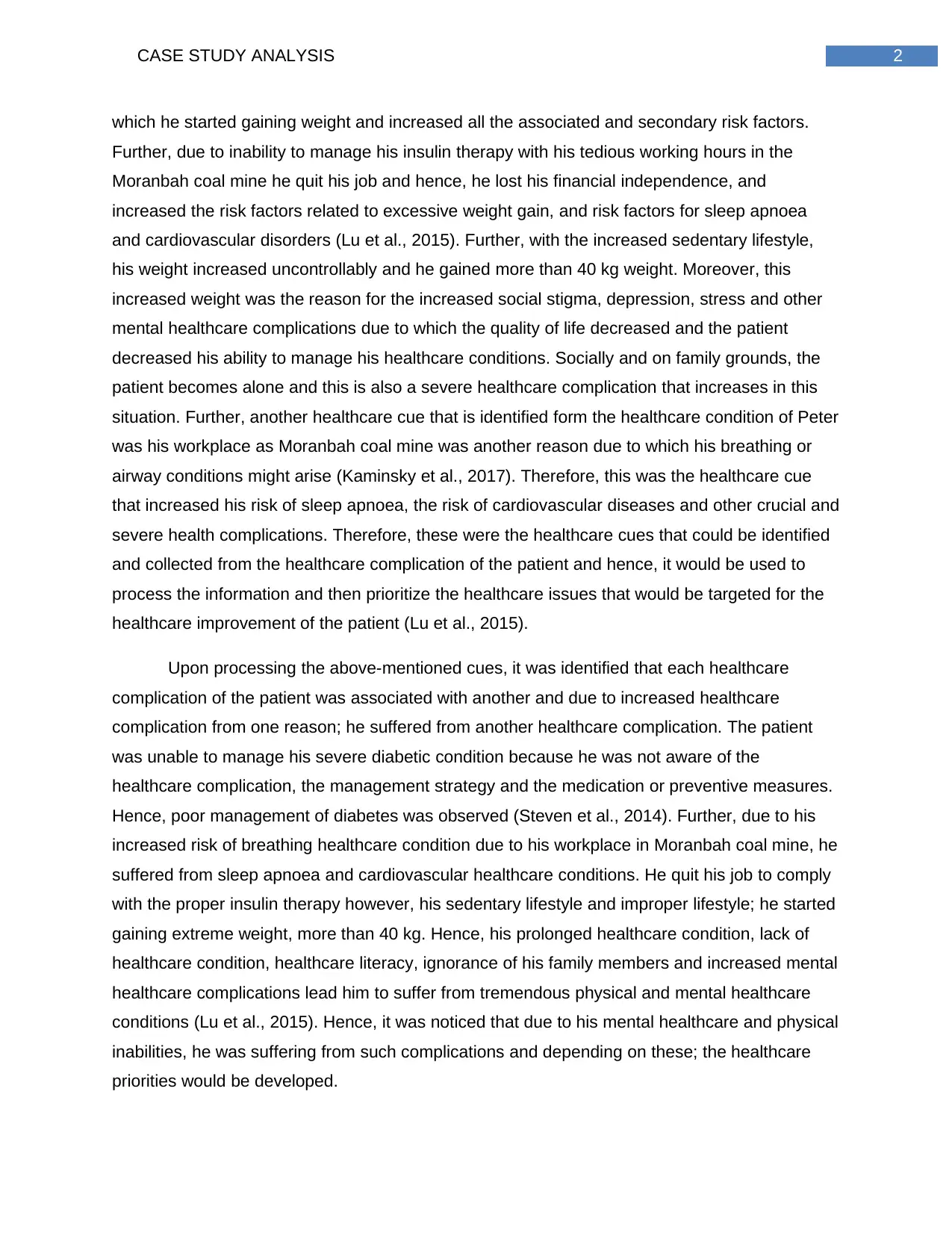
2CASE STUDY ANALYSIS
which he started gaining weight and increased all the associated and secondary risk factors.
Further, due to inability to manage his insulin therapy with his tedious working hours in the
Moranbah coal mine he quit his job and hence, he lost his financial independence, and
increased the risk factors related to excessive weight gain, and risk factors for sleep apnoea
and cardiovascular disorders (Lu et al., 2015). Further, with the increased sedentary lifestyle,
his weight increased uncontrollably and he gained more than 40 kg weight. Moreover, this
increased weight was the reason for the increased social stigma, depression, stress and other
mental healthcare complications due to which the quality of life decreased and the patient
decreased his ability to manage his healthcare conditions. Socially and on family grounds, the
patient becomes alone and this is also a severe healthcare complication that increases in this
situation. Further, another healthcare cue that is identified form the healthcare condition of Peter
was his workplace as Moranbah coal mine was another reason due to which his breathing or
airway conditions might arise (Kaminsky et al., 2017). Therefore, this was the healthcare cue
that increased his risk of sleep apnoea, the risk of cardiovascular diseases and other crucial and
severe health complications. Therefore, these were the healthcare cues that could be identified
and collected from the healthcare complication of the patient and hence, it would be used to
process the information and then prioritize the healthcare issues that would be targeted for the
healthcare improvement of the patient (Lu et al., 2015).
Upon processing the above-mentioned cues, it was identified that each healthcare
complication of the patient was associated with another and due to increased healthcare
complication from one reason; he suffered from another healthcare complication. The patient
was unable to manage his severe diabetic condition because he was not aware of the
healthcare complication, the management strategy and the medication or preventive measures.
Hence, poor management of diabetes was observed (Steven et al., 2014). Further, due to his
increased risk of breathing healthcare condition due to his workplace in Moranbah coal mine, he
suffered from sleep apnoea and cardiovascular healthcare conditions. He quit his job to comply
with the proper insulin therapy however, his sedentary lifestyle and improper lifestyle; he started
gaining extreme weight, more than 40 kg. Hence, his prolonged healthcare condition, lack of
healthcare condition, healthcare literacy, ignorance of his family members and increased mental
healthcare complications lead him to suffer from tremendous physical and mental healthcare
conditions (Lu et al., 2015). Hence, it was noticed that due to his mental healthcare and physical
inabilities, he was suffering from such complications and depending on these; the healthcare
priorities would be developed.
which he started gaining weight and increased all the associated and secondary risk factors.
Further, due to inability to manage his insulin therapy with his tedious working hours in the
Moranbah coal mine he quit his job and hence, he lost his financial independence, and
increased the risk factors related to excessive weight gain, and risk factors for sleep apnoea
and cardiovascular disorders (Lu et al., 2015). Further, with the increased sedentary lifestyle,
his weight increased uncontrollably and he gained more than 40 kg weight. Moreover, this
increased weight was the reason for the increased social stigma, depression, stress and other
mental healthcare complications due to which the quality of life decreased and the patient
decreased his ability to manage his healthcare conditions. Socially and on family grounds, the
patient becomes alone and this is also a severe healthcare complication that increases in this
situation. Further, another healthcare cue that is identified form the healthcare condition of Peter
was his workplace as Moranbah coal mine was another reason due to which his breathing or
airway conditions might arise (Kaminsky et al., 2017). Therefore, this was the healthcare cue
that increased his risk of sleep apnoea, the risk of cardiovascular diseases and other crucial and
severe health complications. Therefore, these were the healthcare cues that could be identified
and collected from the healthcare complication of the patient and hence, it would be used to
process the information and then prioritize the healthcare issues that would be targeted for the
healthcare improvement of the patient (Lu et al., 2015).
Upon processing the above-mentioned cues, it was identified that each healthcare
complication of the patient was associated with another and due to increased healthcare
complication from one reason; he suffered from another healthcare complication. The patient
was unable to manage his severe diabetic condition because he was not aware of the
healthcare complication, the management strategy and the medication or preventive measures.
Hence, poor management of diabetes was observed (Steven et al., 2014). Further, due to his
increased risk of breathing healthcare condition due to his workplace in Moranbah coal mine, he
suffered from sleep apnoea and cardiovascular healthcare conditions. He quit his job to comply
with the proper insulin therapy however, his sedentary lifestyle and improper lifestyle; he started
gaining extreme weight, more than 40 kg. Hence, his prolonged healthcare condition, lack of
healthcare condition, healthcare literacy, ignorance of his family members and increased mental
healthcare complications lead him to suffer from tremendous physical and mental healthcare
conditions (Lu et al., 2015). Hence, it was noticed that due to his mental healthcare and physical
inabilities, he was suffering from such complications and depending on these; the healthcare
priorities would be developed.
⊘ This is a preview!⊘
Do you want full access?
Subscribe today to unlock all pages.

Trusted by 1+ million students worldwide
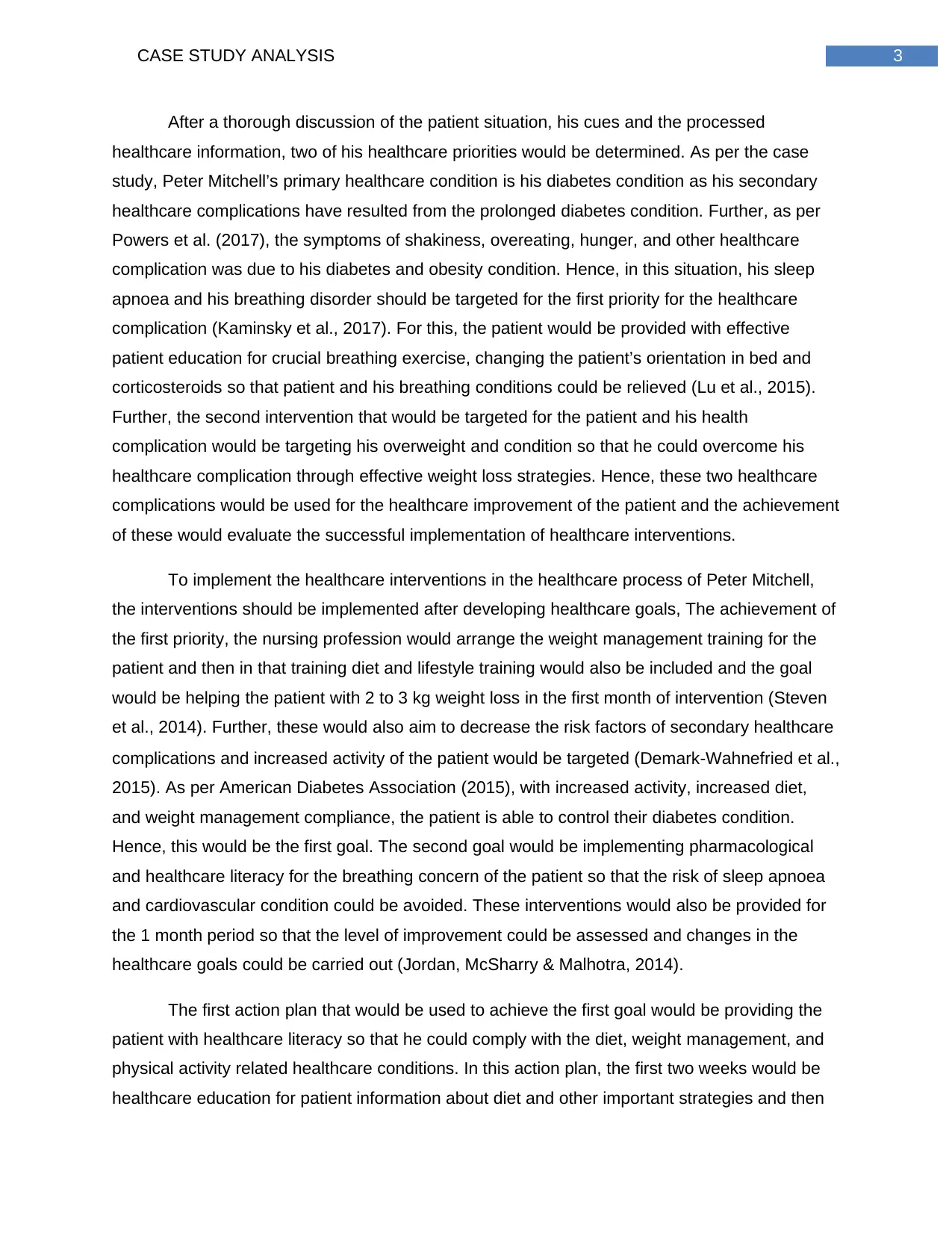
3CASE STUDY ANALYSIS
After a thorough discussion of the patient situation, his cues and the processed
healthcare information, two of his healthcare priorities would be determined. As per the case
study, Peter Mitchell’s primary healthcare condition is his diabetes condition as his secondary
healthcare complications have resulted from the prolonged diabetes condition. Further, as per
Powers et al. (2017), the symptoms of shakiness, overeating, hunger, and other healthcare
complication was due to his diabetes and obesity condition. Hence, in this situation, his sleep
apnoea and his breathing disorder should be targeted for the first priority for the healthcare
complication (Kaminsky et al., 2017). For this, the patient would be provided with effective
patient education for crucial breathing exercise, changing the patient’s orientation in bed and
corticosteroids so that patient and his breathing conditions could be relieved (Lu et al., 2015).
Further, the second intervention that would be targeted for the patient and his health
complication would be targeting his overweight and condition so that he could overcome his
healthcare complication through effective weight loss strategies. Hence, these two healthcare
complications would be used for the healthcare improvement of the patient and the achievement
of these would evaluate the successful implementation of healthcare interventions.
To implement the healthcare interventions in the healthcare process of Peter Mitchell,
the interventions should be implemented after developing healthcare goals, The achievement of
the first priority, the nursing profession would arrange the weight management training for the
patient and then in that training diet and lifestyle training would also be included and the goal
would be helping the patient with 2 to 3 kg weight loss in the first month of intervention (Steven
et al., 2014). Further, these would also aim to decrease the risk factors of secondary healthcare
complications and increased activity of the patient would be targeted (Demark‐Wahnefried et al.,
2015). As per American Diabetes Association (2015), with increased activity, increased diet,
and weight management compliance, the patient is able to control their diabetes condition.
Hence, this would be the first goal. The second goal would be implementing pharmacological
and healthcare literacy for the breathing concern of the patient so that the risk of sleep apnoea
and cardiovascular condition could be avoided. These interventions would also be provided for
the 1 month period so that the level of improvement could be assessed and changes in the
healthcare goals could be carried out (Jordan, McSharry & Malhotra, 2014).
The first action plan that would be used to achieve the first goal would be providing the
patient with healthcare literacy so that he could comply with the diet, weight management, and
physical activity related healthcare conditions. In this action plan, the first two weeks would be
healthcare education for patient information about diet and other important strategies and then
After a thorough discussion of the patient situation, his cues and the processed
healthcare information, two of his healthcare priorities would be determined. As per the case
study, Peter Mitchell’s primary healthcare condition is his diabetes condition as his secondary
healthcare complications have resulted from the prolonged diabetes condition. Further, as per
Powers et al. (2017), the symptoms of shakiness, overeating, hunger, and other healthcare
complication was due to his diabetes and obesity condition. Hence, in this situation, his sleep
apnoea and his breathing disorder should be targeted for the first priority for the healthcare
complication (Kaminsky et al., 2017). For this, the patient would be provided with effective
patient education for crucial breathing exercise, changing the patient’s orientation in bed and
corticosteroids so that patient and his breathing conditions could be relieved (Lu et al., 2015).
Further, the second intervention that would be targeted for the patient and his health
complication would be targeting his overweight and condition so that he could overcome his
healthcare complication through effective weight loss strategies. Hence, these two healthcare
complications would be used for the healthcare improvement of the patient and the achievement
of these would evaluate the successful implementation of healthcare interventions.
To implement the healthcare interventions in the healthcare process of Peter Mitchell,
the interventions should be implemented after developing healthcare goals, The achievement of
the first priority, the nursing profession would arrange the weight management training for the
patient and then in that training diet and lifestyle training would also be included and the goal
would be helping the patient with 2 to 3 kg weight loss in the first month of intervention (Steven
et al., 2014). Further, these would also aim to decrease the risk factors of secondary healthcare
complications and increased activity of the patient would be targeted (Demark‐Wahnefried et al.,
2015). As per American Diabetes Association (2015), with increased activity, increased diet,
and weight management compliance, the patient is able to control their diabetes condition.
Hence, this would be the first goal. The second goal would be implementing pharmacological
and healthcare literacy for the breathing concern of the patient so that the risk of sleep apnoea
and cardiovascular condition could be avoided. These interventions would also be provided for
the 1 month period so that the level of improvement could be assessed and changes in the
healthcare goals could be carried out (Jordan, McSharry & Malhotra, 2014).
The first action plan that would be used to achieve the first goal would be providing the
patient with healthcare literacy so that he could comply with the diet, weight management, and
physical activity related healthcare conditions. In this action plan, the first two weeks would be
healthcare education for patient information about diet and other important strategies and then
Paraphrase This Document
Need a fresh take? Get an instant paraphrase of this document with our AI Paraphraser
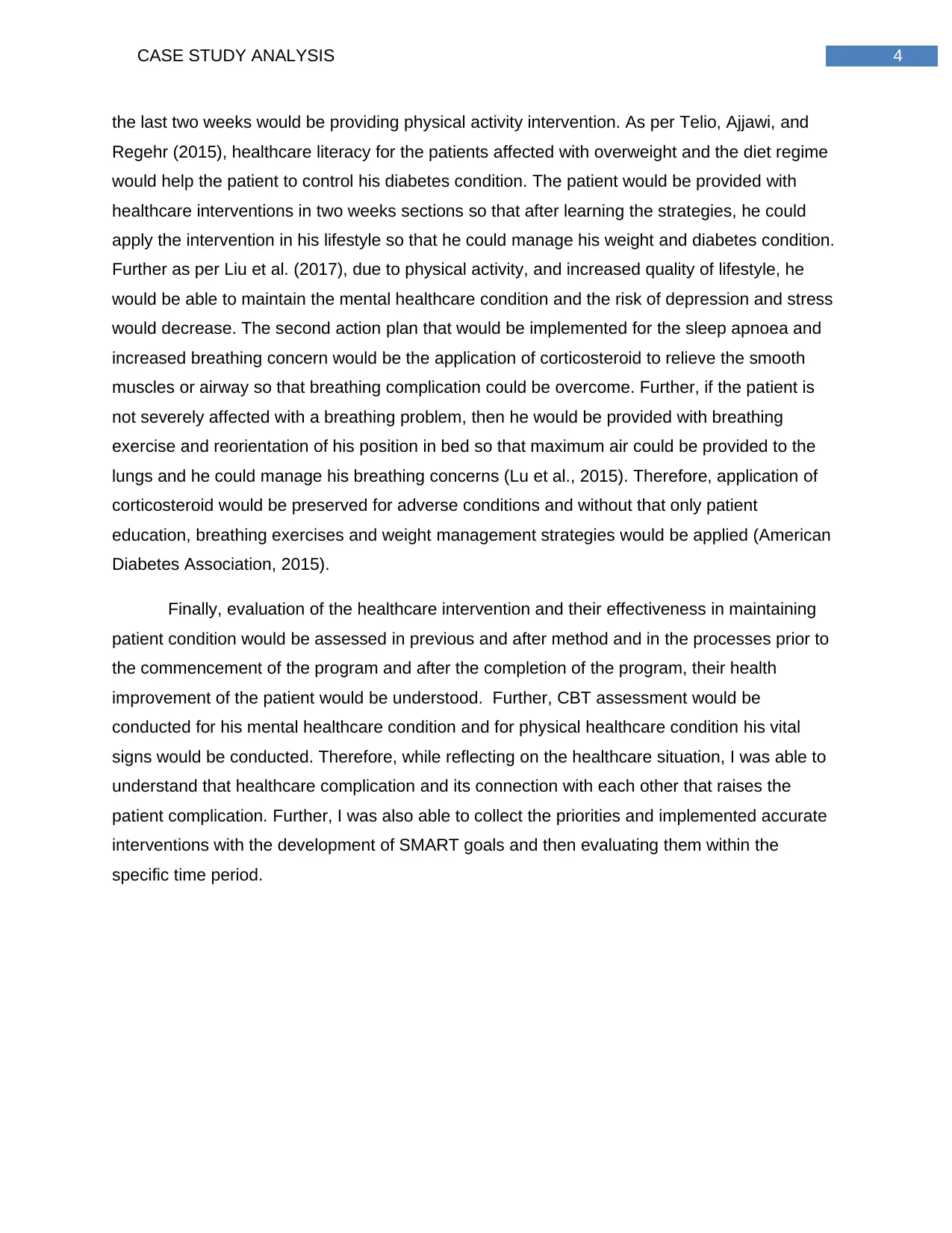
4CASE STUDY ANALYSIS
the last two weeks would be providing physical activity intervention. As per Telio, Ajjawi, and
Regehr (2015), healthcare literacy for the patients affected with overweight and the diet regime
would help the patient to control his diabetes condition. The patient would be provided with
healthcare interventions in two weeks sections so that after learning the strategies, he could
apply the intervention in his lifestyle so that he could manage his weight and diabetes condition.
Further as per Liu et al. (2017), due to physical activity, and increased quality of lifestyle, he
would be able to maintain the mental healthcare condition and the risk of depression and stress
would decrease. The second action plan that would be implemented for the sleep apnoea and
increased breathing concern would be the application of corticosteroid to relieve the smooth
muscles or airway so that breathing complication could be overcome. Further, if the patient is
not severely affected with a breathing problem, then he would be provided with breathing
exercise and reorientation of his position in bed so that maximum air could be provided to the
lungs and he could manage his breathing concerns (Lu et al., 2015). Therefore, application of
corticosteroid would be preserved for adverse conditions and without that only patient
education, breathing exercises and weight management strategies would be applied (American
Diabetes Association, 2015).
Finally, evaluation of the healthcare intervention and their effectiveness in maintaining
patient condition would be assessed in previous and after method and in the processes prior to
the commencement of the program and after the completion of the program, their health
improvement of the patient would be understood. Further, CBT assessment would be
conducted for his mental healthcare condition and for physical healthcare condition his vital
signs would be conducted. Therefore, while reflecting on the healthcare situation, I was able to
understand that healthcare complication and its connection with each other that raises the
patient complication. Further, I was also able to collect the priorities and implemented accurate
interventions with the development of SMART goals and then evaluating them within the
specific time period.
the last two weeks would be providing physical activity intervention. As per Telio, Ajjawi, and
Regehr (2015), healthcare literacy for the patients affected with overweight and the diet regime
would help the patient to control his diabetes condition. The patient would be provided with
healthcare interventions in two weeks sections so that after learning the strategies, he could
apply the intervention in his lifestyle so that he could manage his weight and diabetes condition.
Further as per Liu et al. (2017), due to physical activity, and increased quality of lifestyle, he
would be able to maintain the mental healthcare condition and the risk of depression and stress
would decrease. The second action plan that would be implemented for the sleep apnoea and
increased breathing concern would be the application of corticosteroid to relieve the smooth
muscles or airway so that breathing complication could be overcome. Further, if the patient is
not severely affected with a breathing problem, then he would be provided with breathing
exercise and reorientation of his position in bed so that maximum air could be provided to the
lungs and he could manage his breathing concerns (Lu et al., 2015). Therefore, application of
corticosteroid would be preserved for adverse conditions and without that only patient
education, breathing exercises and weight management strategies would be applied (American
Diabetes Association, 2015).
Finally, evaluation of the healthcare intervention and their effectiveness in maintaining
patient condition would be assessed in previous and after method and in the processes prior to
the commencement of the program and after the completion of the program, their health
improvement of the patient would be understood. Further, CBT assessment would be
conducted for his mental healthcare condition and for physical healthcare condition his vital
signs would be conducted. Therefore, while reflecting on the healthcare situation, I was able to
understand that healthcare complication and its connection with each other that raises the
patient complication. Further, I was also able to collect the priorities and implemented accurate
interventions with the development of SMART goals and then evaluating them within the
specific time period.
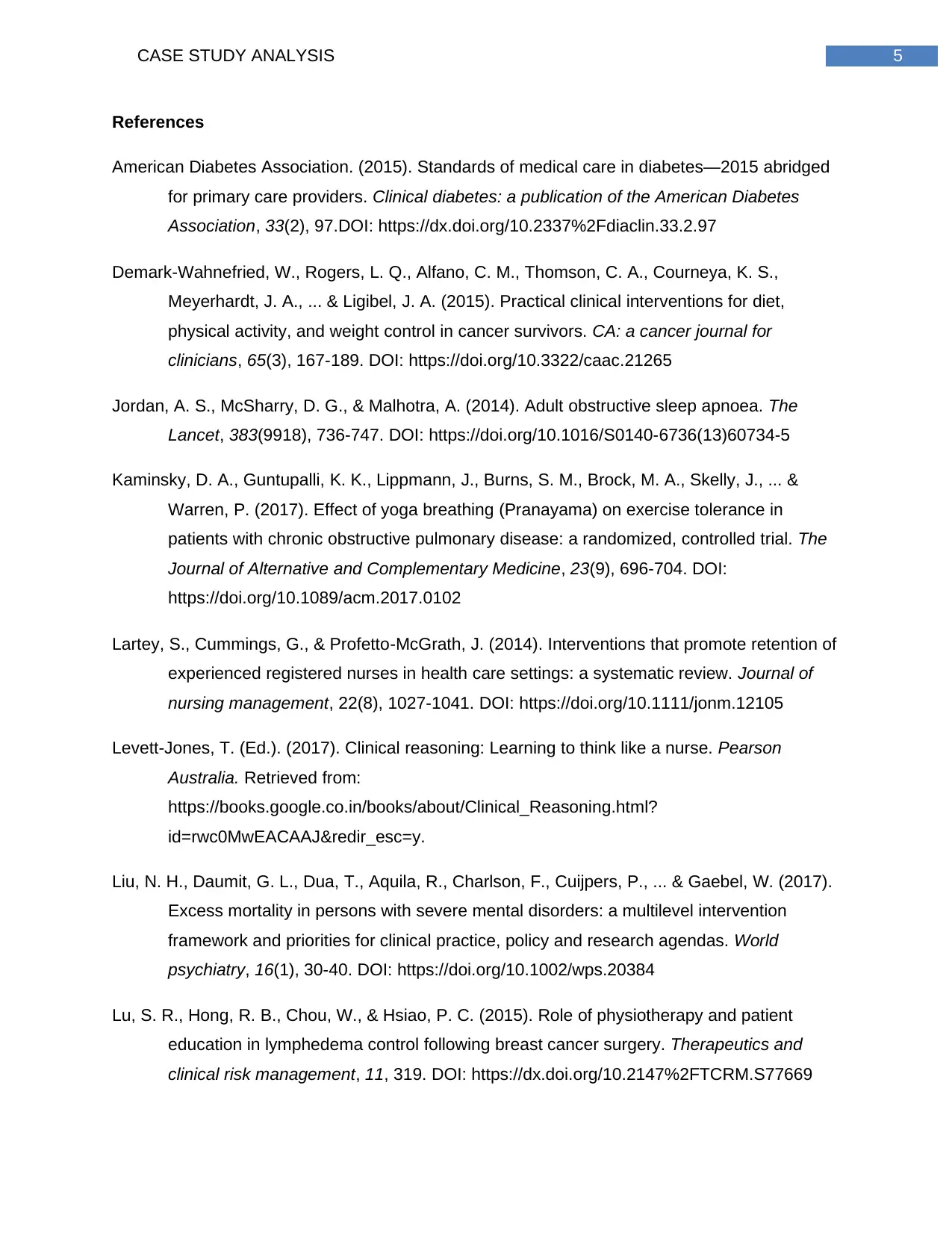
5CASE STUDY ANALYSIS
References
American Diabetes Association. (2015). Standards of medical care in diabetes—2015 abridged
for primary care providers. Clinical diabetes: a publication of the American Diabetes
Association, 33(2), 97.DOI: https://dx.doi.org/10.2337%2Fdiaclin.33.2.97
Demark‐Wahnefried, W., Rogers, L. Q., Alfano, C. M., Thomson, C. A., Courneya, K. S.,
Meyerhardt, J. A., ... & Ligibel, J. A. (2015). Practical clinical interventions for diet,
physical activity, and weight control in cancer survivors. CA: a cancer journal for
clinicians, 65(3), 167-189. DOI: https://doi.org/10.3322/caac.21265
Jordan, A. S., McSharry, D. G., & Malhotra, A. (2014). Adult obstructive sleep apnoea. The
Lancet, 383(9918), 736-747. DOI: https://doi.org/10.1016/S0140-6736(13)60734-5
Kaminsky, D. A., Guntupalli, K. K., Lippmann, J., Burns, S. M., Brock, M. A., Skelly, J., ... &
Warren, P. (2017). Effect of yoga breathing (Pranayama) on exercise tolerance in
patients with chronic obstructive pulmonary disease: a randomized, controlled trial. The
Journal of Alternative and Complementary Medicine, 23(9), 696-704. DOI:
https://doi.org/10.1089/acm.2017.0102
Lartey, S., Cummings, G., & Profetto‐McGrath, J. (2014). Interventions that promote retention of
experienced registered nurses in health care settings: a systematic review. Journal of
nursing management, 22(8), 1027-1041. DOI: https://doi.org/10.1111/jonm.12105
Levett-Jones, T. (Ed.). (2017). Clinical reasoning: Learning to think like a nurse. Pearson
Australia. Retrieved from:
https://books.google.co.in/books/about/Clinical_Reasoning.html?
id=rwc0MwEACAAJ&redir_esc=y.
Liu, N. H., Daumit, G. L., Dua, T., Aquila, R., Charlson, F., Cuijpers, P., ... & Gaebel, W. (2017).
Excess mortality in persons with severe mental disorders: a multilevel intervention
framework and priorities for clinical practice, policy and research agendas. World
psychiatry, 16(1), 30-40. DOI: https://doi.org/10.1002/wps.20384
Lu, S. R., Hong, R. B., Chou, W., & Hsiao, P. C. (2015). Role of physiotherapy and patient
education in lymphedema control following breast cancer surgery. Therapeutics and
clinical risk management, 11, 319. DOI: https://dx.doi.org/10.2147%2FTCRM.S77669
References
American Diabetes Association. (2015). Standards of medical care in diabetes—2015 abridged
for primary care providers. Clinical diabetes: a publication of the American Diabetes
Association, 33(2), 97.DOI: https://dx.doi.org/10.2337%2Fdiaclin.33.2.97
Demark‐Wahnefried, W., Rogers, L. Q., Alfano, C. M., Thomson, C. A., Courneya, K. S.,
Meyerhardt, J. A., ... & Ligibel, J. A. (2015). Practical clinical interventions for diet,
physical activity, and weight control in cancer survivors. CA: a cancer journal for
clinicians, 65(3), 167-189. DOI: https://doi.org/10.3322/caac.21265
Jordan, A. S., McSharry, D. G., & Malhotra, A. (2014). Adult obstructive sleep apnoea. The
Lancet, 383(9918), 736-747. DOI: https://doi.org/10.1016/S0140-6736(13)60734-5
Kaminsky, D. A., Guntupalli, K. K., Lippmann, J., Burns, S. M., Brock, M. A., Skelly, J., ... &
Warren, P. (2017). Effect of yoga breathing (Pranayama) on exercise tolerance in
patients with chronic obstructive pulmonary disease: a randomized, controlled trial. The
Journal of Alternative and Complementary Medicine, 23(9), 696-704. DOI:
https://doi.org/10.1089/acm.2017.0102
Lartey, S., Cummings, G., & Profetto‐McGrath, J. (2014). Interventions that promote retention of
experienced registered nurses in health care settings: a systematic review. Journal of
nursing management, 22(8), 1027-1041. DOI: https://doi.org/10.1111/jonm.12105
Levett-Jones, T. (Ed.). (2017). Clinical reasoning: Learning to think like a nurse. Pearson
Australia. Retrieved from:
https://books.google.co.in/books/about/Clinical_Reasoning.html?
id=rwc0MwEACAAJ&redir_esc=y.
Liu, N. H., Daumit, G. L., Dua, T., Aquila, R., Charlson, F., Cuijpers, P., ... & Gaebel, W. (2017).
Excess mortality in persons with severe mental disorders: a multilevel intervention
framework and priorities for clinical practice, policy and research agendas. World
psychiatry, 16(1), 30-40. DOI: https://doi.org/10.1002/wps.20384
Lu, S. R., Hong, R. B., Chou, W., & Hsiao, P. C. (2015). Role of physiotherapy and patient
education in lymphedema control following breast cancer surgery. Therapeutics and
clinical risk management, 11, 319. DOI: https://dx.doi.org/10.2147%2FTCRM.S77669
⊘ This is a preview!⊘
Do you want full access?
Subscribe today to unlock all pages.

Trusted by 1+ million students worldwide
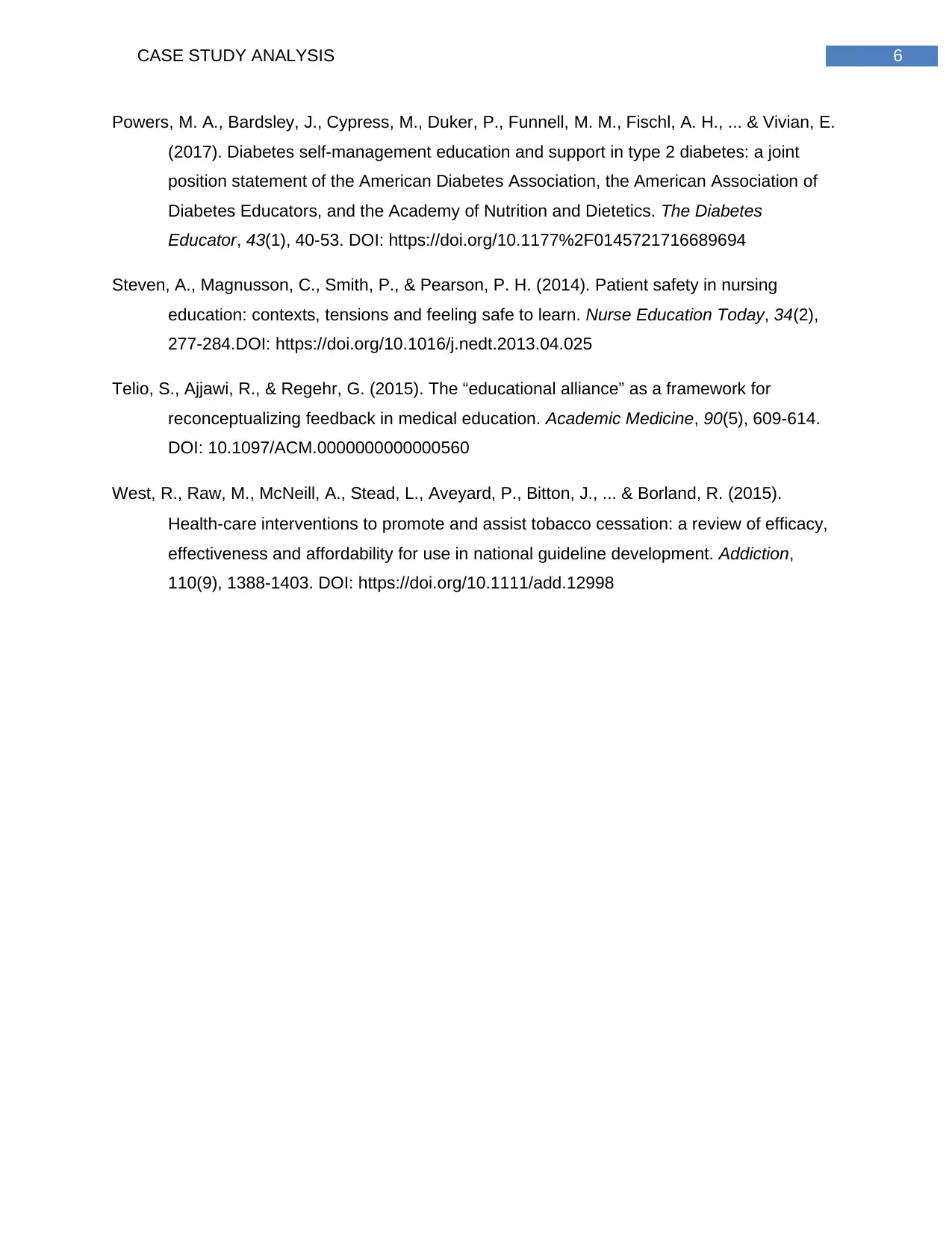
6CASE STUDY ANALYSIS
Powers, M. A., Bardsley, J., Cypress, M., Duker, P., Funnell, M. M., Fischl, A. H., ... & Vivian, E.
(2017). Diabetes self-management education and support in type 2 diabetes: a joint
position statement of the American Diabetes Association, the American Association of
Diabetes Educators, and the Academy of Nutrition and Dietetics. The Diabetes
Educator, 43(1), 40-53. DOI: https://doi.org/10.1177%2F0145721716689694
Steven, A., Magnusson, C., Smith, P., & Pearson, P. H. (2014). Patient safety in nursing
education: contexts, tensions and feeling safe to learn. Nurse Education Today, 34(2),
277-284.DOI: https://doi.org/10.1016/j.nedt.2013.04.025
Telio, S., Ajjawi, R., & Regehr, G. (2015). The “educational alliance” as a framework for
reconceptualizing feedback in medical education. Academic Medicine, 90(5), 609-614.
DOI: 10.1097/ACM.0000000000000560
West, R., Raw, M., McNeill, A., Stead, L., Aveyard, P., Bitton, J., ... & Borland, R. (2015).
Health‐care interventions to promote and assist tobacco cessation: a review of efficacy,
effectiveness and affordability for use in national guideline development. Addiction,
110(9), 1388-1403. DOI: https://doi.org/10.1111/add.12998
Powers, M. A., Bardsley, J., Cypress, M., Duker, P., Funnell, M. M., Fischl, A. H., ... & Vivian, E.
(2017). Diabetes self-management education and support in type 2 diabetes: a joint
position statement of the American Diabetes Association, the American Association of
Diabetes Educators, and the Academy of Nutrition and Dietetics. The Diabetes
Educator, 43(1), 40-53. DOI: https://doi.org/10.1177%2F0145721716689694
Steven, A., Magnusson, C., Smith, P., & Pearson, P. H. (2014). Patient safety in nursing
education: contexts, tensions and feeling safe to learn. Nurse Education Today, 34(2),
277-284.DOI: https://doi.org/10.1016/j.nedt.2013.04.025
Telio, S., Ajjawi, R., & Regehr, G. (2015). The “educational alliance” as a framework for
reconceptualizing feedback in medical education. Academic Medicine, 90(5), 609-614.
DOI: 10.1097/ACM.0000000000000560
West, R., Raw, M., McNeill, A., Stead, L., Aveyard, P., Bitton, J., ... & Borland, R. (2015).
Health‐care interventions to promote and assist tobacco cessation: a review of efficacy,
effectiveness and affordability for use in national guideline development. Addiction,
110(9), 1388-1403. DOI: https://doi.org/10.1111/add.12998
1 out of 7
Related Documents
Your All-in-One AI-Powered Toolkit for Academic Success.
+13062052269
info@desklib.com
Available 24*7 on WhatsApp / Email
![[object Object]](/_next/static/media/star-bottom.7253800d.svg)
Unlock your academic potential
Copyright © 2020–2025 A2Z Services. All Rights Reserved. Developed and managed by ZUCOL.





